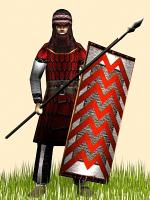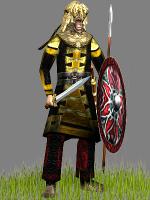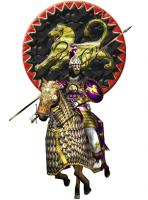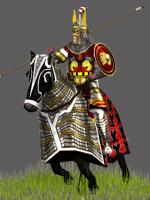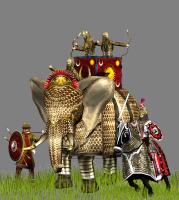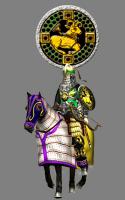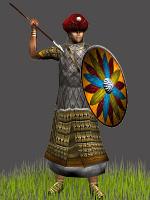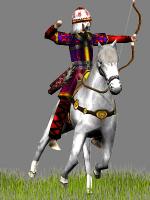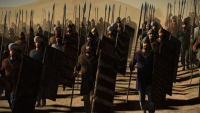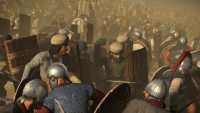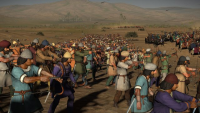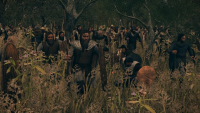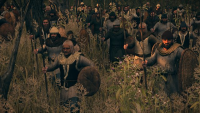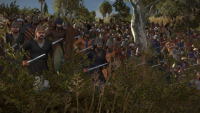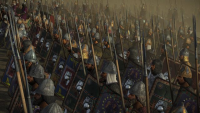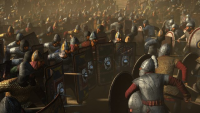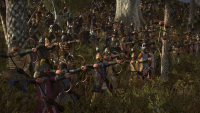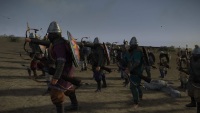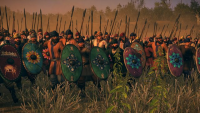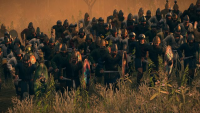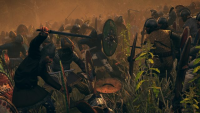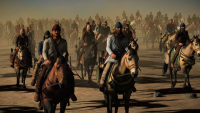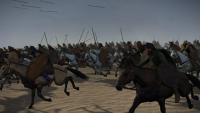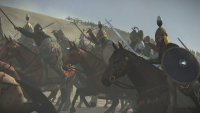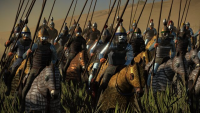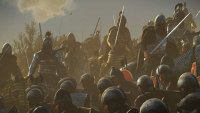
Julian Bashir
Community Members-
Posts
11 -
Joined
-
Last visited
Everything posted by Julian Bashir
-
Surprise! http://www.youtube.com/watch?v=R42thLVG0w0 Introducing Portuguese mod.
-
I found this article in Livescience and i decided to post it on 0 AD forum, hopefully it may help a little bit: The mystery of an ancient battle between two warring troops of elephants has been solved, thanks to a modern genetic analysis of the lumbering beasts. Researchers have now found that Eritrean elephants, which live in the northeastern portion of Africa, are savanna elephants, and are not related to the more diminutive forest elephants that live in the jungles of central Africa. That, in turn, discounts an ancient Greek account of how a battle between two warring empires played out, with one side's elephants refusing to fight and running away, the scientists report in the January issue of the journal of Heredity. [10 Epic Battles That Changed the Course of History] Ancient battle In the third century B.C., the Greek historian Polybius described the epic Battle of Raphia, which took place around 217 B.C. in what is now the Gaza Strip, as part of the Syrian Wars. During these wars, Seleucid ruler Antiochus III the Great fought against Ptolemy IV Philopator, the fourth ruler of the Ptolemaic Dynasty in Egypt, whose last leader wasCleopatra. The matchup included tens of thousands of troops, thousands of cavalry and dozens of war elephants on each side. The elephants were the "ace in the hole," able to trample the enemy and sow terror with their massive size. "Elephants were considered the tanks of the time, until eventually the Romans figured out how to defeat war elephants," in later times, said study co-author Alfred Roca, an animal scientist at the University of Illinois at Urbana-Champaign. Antiochus had easy access to Asian elephants from India, but Ptolemy didn't. Instead, he set up outposts in what is now modern-day Eritrea to get African elephants. Unfortunately, that strategy didn't work out so well: According to Polybius' account, the African elephants turned tail and ran when they saw how gigantic the Asian elephants were. Ptolemy, however, was able to recover due to missteps by Antiochus and eventually won the battle. African elephants In reality, Asian elephants are smaller than African elephants, so some historians speculated that perhaps the Ptolemies were using African forest elephants, which tend to be smaller, Roca said. So Roca and his colleagues conducted a thorough genetic analysis of the elephants found in Eritrea, the descendants of the losers in the ancient battle. "We showed using pretty much every genetic marker, that they were savanna elephants," Roca told LiveScience. "This was contrary to some speculation that there may be forest elephants present in that part of the world." The team also found that there were just 100 to 200 African elephants left in isolated pockets in Eritrea, which could make them susceptible to inbreeding in the future. Ancient myths The findings suggest that Polybius had it wrong, and the African elephants got spooked for some other reason than the overpowering size of the Asian elephants. In other ancient documents, "There were these ancient semi-mythical accounts of India, and they claimed that India had the biggest elephants in the world," Roca said. Polybius, who wasn't actually at the battle, likely read those accounts and surmised the Asian elephants' bigger size caused their opponents to panic. In fact, until about the 1700s, when scientists actually measured the two, most people still thought Asian elephants were the larger species, Roca said. (And even now, games such as Age of Empires that recreate the Battle of Raphia depict the Ptolemaic elephants as smaller.)
-
Historical issue regarding Bagaudae/Bagauda
Julian Bashir replied to Julian Bashir's topic in General Discussion
Your team could use Wikipedia to check whether it's accurate or not for the Celts to have Bagauda before 2nd or 3rd Century AD/CE, but why would your team decide not to do so? -
Historical issue regarding Bagaudae/Bagauda
Julian Bashir replied to Julian Bashir's topic in General Discussion
As a fan of 0 AD, i urged the team to remove Bagauda from the game for now. -
Parthians (or Arsacids) and Sasanians
Julian Bashir replied to Mega Mania's topic in General Discussion
However, there's another mod i think i cannot ignore. Invasio Barbarorum: Ruina Romae proved themselves as an excellent BI mod although they tend to focus on aesthetic than historical accuracy and these are the works: -
Parthians (or Arsacids) and Sasanians
Julian Bashir replied to Mega Mania's topic in General Discussion
Bear in mind that this is not Islamic Persia, but Persia from a different time which could mean that Microsoft was doing a wrong Persian civilization. Constantine: Rise of Christianity mod introduce us a historically accurate Persian Empire in the 3rd Century CE. While most of the mods about Sassanid Persia was a farce, Constantine: Rise of Christianity mod show us that historical accuracy and game play was able to coexist together without sacrificing the former or the latter. -
Parthians (or Arsacids) and Sasanians
Julian Bashir replied to Mega Mania's topic in General Discussion
I think the team should look for Constantine: Rise of Christianity team for advice if they have to since in my opinion they are the best modders that recreate an empire that was long forgotten by history. Here's some of their example unit: Enjoy. -
Historical issue regarding Bagaudae/Bagauda
Julian Bashir replied to Julian Bashir's topic in General Discussion
I am just curious why would the Gauls and Britons have Bagauda before 2nd century AD/CE? That's all i want. -
The Creative Assembly expansion for Rome 2: Total War is here, although it is way better than Rome 2 but there's some issue remains. Here's the link: http://www.honga.net/totalwar/attila/ http://www.honga.net/totalwar/attila/faction.php?l=en&v=attila&f=att_fact_sassanid_empire&i= Thank you.
-
Greetings, i am Julian Bashir. This is my first time download and play a free real-time strategy games especially when it have a rare historical background which most game producer wouldn't consider about. I must admit i love it although it have some technical and historical issue but nonetheless it was good game. I hope i could play a complete version of 0AD sometime in the far future.
-
I have become aware about the Bagauda unit in 0 AD where the Gauls and Britons was able to train them while articles from Ancient Warfare magazine tells a different story, here's the article from Ancient Warfare Magazine: Out of the chaos of civil war and economic collapse that characterized the Roman Empire in the third century AD, came a prolonged series of revolts that threatened the very fabric of Roman society. These revolts were most prevalent in the west, particularly in Spain and Gaul. Here, escaped slaves, oppressed peasants and even disillusioned municipal officials, physicians and landowners banded together with military deserters to defy Imperial authority. These rebels were called Bacaudae (or Bagaudae). By the fifth century AD, they had become so powerful that they were minting their own coins and were strong enough to require the Imperial authorities to call in barbarian armies to suppress them. The Spartacus revolt is well known, thanks in part to Hollywood, yet the Bacaudae, who were more successful and who survived for more than two centuries, are virtually unknown. The increased use of barbarians in the Roman army was in partly a response to the impact of the Bacaudae. Alans, for example, were settled around the city of Aurelianum (modern Orléans) to keep the Bacaudae of Armorica (now Brittany) in check. Early revolts Although the Bacaudae are most notable for their activities towards the end of the Roman Empire in the West, revolts were recorded as early as the second century. The calamitous wars of Marcus Aurelius, followed by plague, currency devaluation and corruption led to a great revolt in 186 led by a former soldier by the name of Maternus. According to Herodian, our main source, Maternus “gathered together a numerous band of rascals, and at first he overran villages and estates, and plundered them; but when he was master of great wealth he collected a more numerous throng of rascals with promises of large gifts and a share of what was taken, so that they no longer had the status of brigands but of enemies. For they now proceeded to attack the largest cities, and forcing open the prisons they set free those who had been confined in them, no matter what they had been charged with, promised them impunity, and by good treatment won them over to join them. They overran the whole land of the Gauls and the Spaniards attacking the largest cities, burning parts of them and plundering the rest before retiring.” Many of Maternus’ followers were initially army deserters like himself but as the the revolt gained momentum he was joined by many others. In a relatively short time it seems as though the rebels had near complete control of much of Gaul and Spain. It took several campaigns to regain central control. Two legions were brought over from Britain to restore order in Armorica and a military campaign led by Pescennius Niger had some success. Despite the military action against him, however, Maternus was still strong enough a year later to contemplate an invasion of Italy. His intent was to assassinate the Emperor Commodus and set himself up in his place. This did not seem to go down well with his followers, who betrayed him. The execution of Maternus did not end revolts against the central authority of the Empire. Although the term “Bacaudae” did not come into use until the third century, the coming together of brigands, deserters, escaped slaves, impoverished peasants to set up some sort of Robin Hood-like alternative society carried on through the second and third centuries. The weakening of central authority in the civil wars that followed the death of Commodus was probably a contributing factor as was currency devaluation and economic decline. Only twenty years after the death of Maternus, four legions were required to conduct a campaign against rebels in Gaul. In the second century, these revolts seemed to be led by army deserters. Interestingly, many other deserters went over to join the various barbarian tribes on the other side of the Rhine and Danube. Marcus Aurelius’ peace settlement with the Marcomanni included the demand to return thousands of deserters. It is not unlikely that such large numbers of former Roman soldiers going over to the barbarians had an impact on improving the military capabilities of the German tribes. By the end of the third century, the Emperor Diocletian had managed to restore some order to the empire. However, he was forced to appoint Maximian as co-ruler in the West with the specific task of crushing the Bacaudae. He achieved temporary success, although part of his army mutinied rather than fight the rebels. The Bacaudae were never really defeated. In the early fifth century, the authorities had to call in the Visigoths to deal with the Bacaudae in Spain and the Huns and Alans to contain them in Gaul. In Britain, the Saxons were brought in to deal with Irish raiders and it is quite possible that Romano-British warlords who fought the Saxons – such as the legendary Arthur – may well have had origins that were similar to the Gallic Bacaudae. Who were the Bacaudae? The term “Bacaudae” first came to be applied in the end of the third century. By then it seems that army deserters were less prominent amongst them. While second century sources frequently mention army deserters as the core rebels, writers from the third century onwards rarely speak of military men amongst the Bacaudae. More often they are referred to disparagingly as “rustics” and “slaves”. The name they took for themselves appears to have a Celtic root and may derive from baga (“warrior”). The economic and social reforms of the Emperor Diocletian (r. 284–305) bound people to their professions. A soldier’s son had to become a soldier, a peasant’s son had to be a peasant and was tied by life to a patch of land probably owned by an aristocratic magnate. Service as a magistrate was also hereditary and unavoidable. Such men were responsible for collecting taxes from an increasingly impoverished population. If they were unable to raise their quota, they had to make up any shortfall from their own pockets. As a result, it was not only slaves who might think about “taking to the woods” to avoid their lot and find an alternative way of life. It was, therefore, a wide range of people from different backgrounds who came together to make up the Bacaudae. There were deserters and escaped slaves to be sure but also farmers, craftsmen and educated townspeople. What they had in common was a desire to escape the situation they had been born into and find greater freedom to run their own affairs. The Bacaudae had recognized leaders and some of these were named by Roman writers. In 286: “Aelianus and Amandus gathered a band of farmers and brigands, whom the Gauls called Bacaudae, and, ravaging the countryside far and wide, assailed many cities” (Aurelius Victor, De Caes. 39.15). Tibatto led the Baccaudae of Armorica during the mid-fifth century, while another prominent Gallic Bacauda sought refuge with Attila the Hun. Roman demands for his return were among the factors that led to the Hun invasion of Gaul in 451. In 449, a man called Basilius led the Bacaudae in Tarraconensis (northern Spain) in a rebellion that saw them killing the bishop of Turiasso (modern Tarazona) and still defying Imperial authority when Visigoths were sent against them in 454. Military operations For the most part, the Bacaudae wanted to be left alone and fought mainly on the defensive against the many attempts by the central authorities to regain control. They did, however, make frequent raids on towns and large estates to secure food and supplies that they could not produce themselves. They also conducted ambushes on the roads to gain plunder. One such ambush in the fourth century resulted in the death of the brother-in-law of the Emperor Valentinian I. The fifth-century poet Merobaudes, who himself was involved with attempts to suppress the Bacaudae in Spain, wrote of the rebels of the “Armorican wilds.” He says that they had fought against the “efforts of Caesar” and that “the land was accustomed to conceal within its forests plunder obtained by savage crime.” Although the Roman armies sent against them encountered significant difficulties, the Bacaudae never had any chance in open battle. Therefore, like modern insurgents, they avoided battle and defended their territory through a series of ambushes, diversions and skirmishes. They would strike when there was a chance of success and melt back into the hills and forests when overwhelming force was brought against them. Roman authors seemed reluctant to say much about these encounters. Ammianus, for example, says that “battles less worthy of description were fought throughout various regions of Gaul, which it is superfluous to narrate both because their outcome resulted in nothing worth speaking of and because it is unbecoming to prolong a history with ignoble details.” Due to their guerrilla tactics, properly defeating the Bacaudae was no easy matter. One Armorican revolt in 407, which coincided with the invasion of Gaul by several Germanic tribes, took ten years to suppress. Less than twenty years later, Tibbato led another Armorican rebellion. He was defeated and captured by the authorities in 437, but escaped to lead the Bacaudae again in 442. The fact that he was not immediately executed and that he was able to escape hints at some degree of collusion on the part of his captors. Eventually, as in all long term insurgencies, some sort of accommodation had to be reached. This was especially true in the fifth century, when all available manpower had to be concentrated on dealing with barbarian incursions and could not be tied up with internal revolts. When Attila invaded Gaul in 451, Armoricans fought alongside Aetius who previously had been their most bitter enemy. It may be that Aetius agreed to some form of local autonomy for the Armorican Bacaudae in exchange for their support. A passage from Zosimus indicates that this may have been the case. It also hints at Bacaudic activity in Britain (6.5): “Accordingly the Britons took up arms and, with no consideration of the danger to themselves, freed their own cities from barbarian threat; likewise all of Armorica and other Gallic provinces followed the Britons’ lead: they freed themselves, ejected the Roman magistrates, and set up home rule at their own discretion.” This passage could be interpreted in different ways. Zosimus says that the Britons fought against barbarians not against the central authorities, yet his connection between them and the Armoricans, who clearly were in rebellion, does give some pause for thought. The legacy of the Bacaudae It is really not surprising that the various Germanic tribes that swept into France and Spain in the mid-fifth century were so easily able to establish kingdoms in the former Roman territories when the local population did not support Imperial authority. Initially, the emperors employed barbarian mercenaries to suppress the revolts, but the later invaders, such as the Franks who came to stay, were probably easier masters to bear than the heavy hand of Imperial bureaucracy. There is no direct evidence of collusion between the Bacaudae and the barbarians in Gaul, but there is in Spain. In the mid-fifth century, Rechiar, King of the Suebi, apparently made an alliance with the local Bacaudae to help secure his position. The situation in Britain is far less clear and there is no evidence of Bacaudic uprisings in that province. It could be that the Romano-British warlords, like the legendary Arthur, saw themselves as the heirs of Roman authority resisting Saxon invaders. On the other hand, as the Saxons were initially brought to Britain as mercenaries by the Imperial authorities. British resistance could, therefore, have started out as a more rebellious movement. It is unlikely that we will ever know for certain. Probably the greatest lasting legacy of the Bacaudae was in their stronghold of Armorica or Brittany. This remained a semi-autonomous state until the 1500s. Here, their Celtic language, although dying out, is still spoken today. Thank you.


